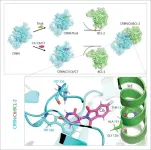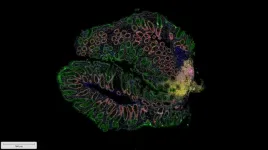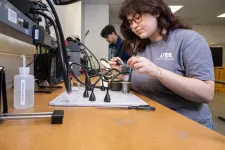(Press-News.org) FRANKFURT. Hardly any other molecule has a more turbulent past than thalidomide. It was the central ingredient in a drug approved in many countries in the 1950s as a sedative and sleeping pill. However, it soon became apparent that pregnant women who had taken thalidomide often gave birth to children with severe deformities.
For the past few decades, however, medicine has nevertheless pinned great hopes on it again. Studies have shown, among other things, that it inhibits the growth of blood vessels and is therefore potentially suitable for cutting off tumors from their nutrient supply. It then also proved very effective in the treatment of multiple myeloma, malignant tumors in the bone marrow.
“We know now that thalidomide is something referred to as a ‘molecular glue’,” explains Dr. Xinlai Cheng from the Institute of Pharmaceutical Chemistry at Goethe University Frankfurt. “This means it is able to catch hold of two proteins and pull them together.” This is particularly interesting because one of these proteins is a kind of ‘labeling machine’: It attaches an unmistakable label to the other protein that says “WASTE”.
The cell’s waste disposal system recognizes this label: It catches hold of the marked protein molecule and shreds it. “It is precisely this mechanism that explains the different effects of thalidomide,” says Cheng. “Depending on which protein is marked, it can lead to malformations during embryonal development or else kill off malignant cells.”
This mechanism opens up great possibilities for medicine because cancer cells are dependent on certain proteins to survive. If these could be systematically targeted and shredded, it might be possible to cure the disease. The problem is that molecular glue is rather idiosyncratic. One of its binding partners is always the cell’s labeling machine, or in scientific terms an E3 ligase called CRBN. Only very few of the many thousands of proteins in the body come into question as the other partner – which ones exactly vary from glue to glue.
“That is why we produced a range of thalidomide derivatives,” says Cheng. “We then examined whether they have glue-like properties and, if so, which proteins they are effective against.” To do this, the researchers added their derivatives to all the proteins in a cultured cell line. They then monitored which of these proteins were subsequently degraded in the presence of CRBN.
“During the process, we pinpointed three derivatives that are able to mark a cell protein which is very important for degradation, BCL-2,” explains Cheng. “BCL-2 prevents the activation of the cellular self-destruction program, so if it is absent, the cells perish.” That is why BCL-2 has already been in the spotlight of cancer research for some time. There is even already a drug for treating leukemia, called venetoclax, which reduces the efficacy of BCL-2 and in this way causes mutated cells to self-destruct.
“In many cancer cells, however, BCL-2 itself is mutated. As a result, venetoclax no longer inhibits the protein,” says Cheng. “We were able to show that our derivatives also mark this mutated form for degradation. Moreover, our partners at the Max Planck Institute of Biophysics simulated the interaction of the thalidomide derivatives with BCL-2 on the computer. This showed that the derivatives bind to completely different sites than venetoclax – a result that we were later also able to corroborate experimentally.”
In addition, the researchers tested their substances in fruit flies with cancerous cells. The survival rate of flies treated in this way was much higher. However, Cheng warns against exceedingly high expectations, as these results are still basic research: “Although they show that modified thalidomide molecules have great therapeutic potential, we cannot say yet whether they will actually prove themselves in practice at some point in time.”
The work was supported by DFG, the Frankfurt Cancer Institute, and the PROXIDRUGS project.
END
Derivatives of the thalidomide compound drive resistant cancer cells to their deaths
Thalidomide derivatives mediate the degradation of proteins needed by mutated cells to survive
2024-05-14
ELSE PRESS RELEASES FROM THIS DATE:
UK survey finds “disgust factor” needs to be overcome if eating insects is to become truly mainstream
2024-05-14
UK survey examines consumer attitudes towards and willingness to consume insect-based foods.
Only 13% of respondents said they would be willing to regularly consume insects, with younger respondents less willing to give insects a try, as were those with higher sensitivity to food disgust.
*Please mention the European Congress on Obesity (ECO 2024, Venice,12-15 May) if using this material*
New research being presented at this year’s European Congress on Obesity (ECO) in Venice, Italy (12-15 May), finds that insect-based foods remain unappealing ...
Could WhatsApp profile pictures help obesity doctors spot patients with body dysmorphia?
2024-05-14
New research being presented at the European Congress on Obesity (ECO) in Venice, Italy (12-15 May) has found that many people who are living with obesity conceal their body in their WhatsApp profile pictures.
Profile pictures of pets, family members, landscapes, flowers and cartoon characters may indicate the individual has body dysmorphic disorder, says lead Dr Antonella Franceschelli, of Unicamillus International Medical University, Rome, Italy.
Body dysmorphic disorder is a condition in which a person has a distorted image of their body. They feel dissatisfied with their physical appearance, may experience shame or anxiety about their body and, in the case ...
It’s time to use TikTok to talk to young people about obesity
2024-05-14
There is an urgent need to harness the potential of TikTok and other social media channels to provide scientific information about obesity to young people in engaging and accessible way, the European Congress on Obesity (ECO) in Venice, Italy (12-15 May) will hear.
The popularity and broad reach of such platforms provides the opportunity to reach diverse audiences, including teenagers and young adults, explains lead researcher Dr Antonella Franceschelli, of Unicamillus International Medical University, Rome, Italy.
The percentage of obese children and adolescents worldwide more than quadrupled among girls (from 1.7% to 6.9%) ...
Allen Institute for Immunology and Seattle Children’s Research Institute launch study to unravel molecular mysteries of pediatric IBD
2024-05-13
By Jake Siegel
Seattle, WA—May 13, 2024—With pediatric inflammatory bowel disease (IBD) diagnoses on the rise globally, a clinical trial in Seattle aims to transform treatment approaches through deep molecular profiling.
Recruitment has begun for the Seattle STRIDE study, a joint effort by Seattle Children’s Research Institute and the Allen Institute for Immunology. The trial aims to enroll 200 volunteers and follow them over three years. It will employ a range of genomic tools to analyze intact tissue samples from routine tests. ...
Impact Journals at SSP 46th Annual Meeting
2024-05-13
Impact Journals is proud to participate at the Society for Scholarly Publishing (SSP) 46th Annual Meeting.
BUFFALO, NY- May 13, 2024 – Impact Journals is proud to participate as an exhibitor at the Society for Scholarly Publishing (SSP) 46th Annual Meeting, which convenes in Boston, Massachusetts, at the Westin Boston Seaport District from May 29–31, 2024. This year, the SSP Annual Meeting theme is “Inflection Point: Setting the Course for the Future of Scholarly Communication.”
Visit booth #212 at the SSP 46th Annual Meeting 2024 to connect with members of the Impact Journals team.
About ...
UTA receives Innovation and Economic Prosperity designation
2024-05-13
UTA has recently received the Innovation and Economic Prosperity (IEP) designation from APLU, the Association of Public and Land Grant Universities.UTA has recently received the Innovation and Economic Prosperity (IEP) designation from APLU, the Association of Public and Land Grant Universities.UTA has recently received the Innovation and Economic Prosperity (IEP) designation from APLU, the Association of Public and Land Grant Universities.UTA has recently received the Innovation and Economic Prosperity (IEP) designation from APLU, the Association of Public and Land Grant ...
Texas Tech researchers help confirm first case of avian influenza transmitted from cow to human
2024-05-13
Texas Tech University’s Biological Threat Research Laboratory (BTRL) played a key role in detecting the first case of highly pathogenic avian influenza (HPAI) A (H5N1) transmitted from a mammal (dairy cow) to a human.
The case was made public in an article published in the New England Journal of Medicine. Steve Presley, the director of The Institute of Environmental and Human Health (TIEHH) and the BTRL, and Cynthia Reinoso Webb, the biological threat coordinator at TIEHH, were co-authors on the journal publication.
The journal article explains that in March a farm worker who reported no contact with ...
Coming out to a chatbot?
2024-05-13
Today, there are dozens of large language model (LLM) chatbots aimed at mental health care — addressing everything from loneliness among seniors to anxiety and depression in teens.
But the efficacy of these apps is unclear. Even more unclear is how well these apps work in supporting specific, marginalized groups like LGBTQ+ communities.
A team of researchers from the Harvard John A. Paulson School of Engineering and Applied Sciences, Emory University, Vanderbilt University and the University of California Irvine, found that while large language models can offer fast, on-demand support, they frequently fail to grasp the specific challenges that many members ...
Persistent strain of cholera defends itself against forces of change, scientists find
2024-05-13
A deadly strain of cholera bacteria that emerged in Indonesia back in 1961 continues to spread widely to this day, claiming thousands of lives around the world every year, sickening millions — and, with its persistence, baffling scientists. Finally, in a study published today in Nature, researchers from The University of Texas at Austin have discovered how this dangerous strain has held out over decades.
A longstanding mystery about the strain of Vibrio cholerae (V. cholerae) responsible for the seventh global cholera pandemic is how this lineage has managed ...
Rice study reveals insights into protein evolution
2024-05-13
Rice University’s Peter Wolynes and his research team have unveiled a breakthrough in understanding how specific genetic sequences, known as pseudogenes, evolve. Their paper was published May 13 by the Proceedings of the National Academy of Sciences of the United States of America Journal.
Led by Wolynes, the D.R. Bullard-Welch Foundation Professor of Science, professor of chemistry, biosciences and physics and astronomy and co-director of the Center for Theoretical Biological Physics (CTBP), the team focused on deciphering the complex energy landscapes of de-evolved, putative protein sequences corresponding to pseudogenes.
Pseudogenes are ...
LAST 30 PRESS RELEASES:
Why nail-biting, procrastination and other self-sabotaging behaviors are rooted in survival instincts
Regional variations in mechanical properties of porcine leptomeninges
Artificial empathy in therapy and healthcare: advancements in interpersonal interaction technologies
Why some brains switch gears more efficiently than others
UVA’s Jundong Li wins ICDM’S 2025 Tao Li Award for data mining, machine learning
UVA’s low-power, high-performance computer power player Mircea Stan earns National Academy of Inventors fellowship
Not playing by the rules: USU researcher explores filamentous algae dynamics in rivers
Do our body clocks influence our risk of dementia?
Anthropologists offer new evidence of bipedalism in long-debated fossil discovery
Safer receipt paper from wood
Dosage-sensitive genes suggest no whole-genome duplications in ancestral angiosperm
First ancient human herpesvirus genomes document their deep history with humans
Why Some Bacteria Survive Antibiotics and How to Stop Them - New study reveals that bacteria can survive antibiotic treatment through two fundamentally different “shutdown modes”
UCLA study links scar healing to dangerous placenta condition
CHANGE-seq-BE finds off-target changes in the genome from base editors
The Journal of Nuclear Medicine Ahead-of-Print Tip Sheet: January 2, 2026
Delayed or absent first dose of measles, mumps, and rubella vaccination
Trends in US preterm birth rates by household income and race and ethnicity
Study identifies potential biomarker linked to progression and brain inflammation in multiple sclerosis
Many mothers in Norway do not show up for postnatal check-ups
Researchers want to find out why quick clay is so unstable
Superradiant spins show teamwork at the quantum scale
Cleveland Clinic Research links tumor bacteria to immunotherapy resistance in head and neck cancer
First Editorial of 2026: Resisting AI slop
Joint ground- and space-based observations reveal Saturn-mass rogue planet
Inheritable genetic variant offers protection against blood cancer risk and progression
Pigs settled Pacific islands alongside early human voyagers
A Coral reef’s daily pulse reshapes microbes in surrounding waters
EAST Tokamak experiments exceed plasma density limit, offering new approach to fusion ignition
Groundbreaking discovery reveals Africa’s oldest cremation pyre and complex ritual practices
[Press-News.org] Derivatives of the thalidomide compound drive resistant cancer cells to their deathsThalidomide derivatives mediate the degradation of proteins needed by mutated cells to survive




